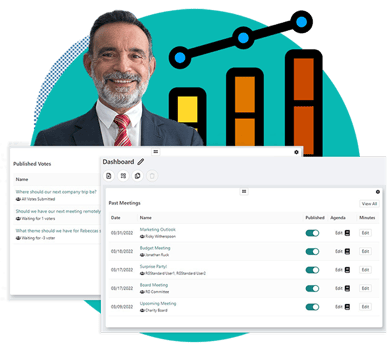The traditional board meeting is dead—what now?
Forty-three percent of board members say that, while virtual meetings are more efficient, they find directors are less engaged, the board is less effective, and boardroom culture is suffering. Ad-hoc resources are dedicated to creating extensive board books, while meeting time is spent going through canned slides, leaving little time for important discussions about key issues.
Organizations are often working with limited resources while facing strong competition and other challenges. The current process of running board meetings demands urgent revision. The board’s ability to efficiently manage a company’s resources can make or break the entire organization.
We've got some proven best practices for how to boost boardroom engagement and productivity, and turn your board meetings into a platform for strategy, innovation, and growth. 
How to Plan Your Best Board Meeting
Board meetings don't need to be too formal. They just need to get the work done.
Since every board is unique, “getting the work done” means different things to different boards. There are no firm rules for planning board meetings, but these best practices help boards prioritize key objectives and efficiently use board members’ limited time.
Each company needs to find the ideal meeting format that works for them. Keeping a consistent format will help maintain focus and productivity, and keep everyone organized.
6 Board Meeting Best Practices
The following guidelines will help build a consistent meeting format that maximizes results every time you meet.
1) Choose the Most Appropriate Venue
When possible, try to have meetings at the company office. This helps give the board a feel for the company, and it also provides accessibility to team members who may be needed.
2) Set Two Strategic Topics Per Board Meeting
Prioritizing only two key topics for the board meeting is a rule of thumb that keeps board meetings productive and efficient. Plan to address the most pressing issues first, and schedule up to 30 minutes per issue.
Set the precedent that your meetings will address issues rather than focusing solely on updates. Updates are important, but most of that information can be presented effectively in the pre-meeting board book.
3) Have a Standard Board Book
A board book, or a collection of reports detailing critical company developments since the most recent board meeting, is essential for meetings. To simplify board meeting preparation, boards should have a standard board book template to follow. That way, directors know what to expect for each meeting.
Board books may be overloaded with information that's difficult to read and digest, so it is a good idea to translate information into graphs wherever possible. Digital board books help with versioning control, real-time editing, ease of accessibility, and more.
 4) Send Out the Board Book At Least 2–3 Days in Advance
4) Send Out the Board Book At Least 2–3 Days in Advance
If you're using a physical board books, timing is everything. If board materials are sent out too early, the report may become buried and forgotten, and information may change. But if it’s sent too late, the board may not have enough time to review it. The sweet spot is to send the board book to directors two to three days in advance of the meeting. Then, ask them to review the board materials at least 24 hours before the meeting.
Consistent preparation equips board members with the necessary tools to focus on governance and make informed decisions.
5) Allot Three Hours
Most board meetings have a reputation for being boring. If you can keep your meetings on schedule and focused on current issues, meetings become engaging and purposeful. There are three things you can do to keep board meetings within that three-hour block of time.
-
Avoid socializing at the beginning and in the middle of meetings.
-
Schedule meetings in the afternoon and host a post-meeting social dinner.
-
Use board management software that lets directors annotate agendas and share notes before, during, and after meetings.
6) Set Up Meetings Well in Advance
Attendance from every director can help the board be more cohesive and productive. Schedule the meetings far in advance so directors can block their schedules. If a time isn’t working for one or more board members, find a new time for board meetings. 
How to Run Effective Board Meetings
The chair of the board holds much of the responsibility to run effective meetings. There are some simple tips they can follow to do their part in supporting successful board meetings:
-
Set the tone at the start of the meeting.
-
If you're not connecting with a board member during a meeting, find different ways outside of the meeting to create cohesion among the group.
-
Use phone calls, private dinners, and managerial meetings to communicate with board members.
-
Keep meetings on track by allowing only brief diversions.
Do's and Don’ts for Managing an Effective Board Meeting
 DO avoid the cheering section. Don't waste time building support for the company in meetings. Focus on making excellent decisions in real time.
DO avoid the cheering section. Don't waste time building support for the company in meetings. Focus on making excellent decisions in real time.
DO avoid long answers. Respectfully redirect drifting discussions—particularly from other board members—at the appropriate time.
DO reach out. Encourage discussion and clarification of information prior to the meeting, so meetings can focus on making decisions that move the business forward.
DO hold social time. Wait until after the meeting, after important board matters have been discussed and the focus can shift to bonding and building rapport.
DON’T let problems hold you back. Don’t be afraid to communicate challenges with the board expediently. Your board members are accustomed to the risks of business. Once the problem is out in the open, the board can design a strategy to correct the issue and avoid future failures.
DON’T get into disruptive arguments. It's easy to feel attacked during a heated discussion with a board member. Regardless of how the board acts, it is your responsibility to lead by example, and mean it. It's fine to push back, but directors must maintain a respectful disposition. The best way to manage the board is by sticking to the basics and remembering that every board member shares a common goal.
DON’T hide your passion. Demonstrate your passion for what you do. Continually let the board know that you are excited and committed to your work. Let your enthusiasm be infectious!
How to Make the Most of Board Relationships
How you utilize the time you spend building your relationship with the board will have implications on the success of the organization as a whole. The building blocks of this relationship are created in the boardroom, but your preparation for each meeting will affect the quality of each relationship.
Prepare yourself and the other board members for each meeting. As you learn how your board communicates, you’ll be able to mold your meetings and your company into a successful enterprise.
LEARN STRENGTHS AND WEAKNESSES
Learning the strengths and weaknesses of your board members will help you craft meetings to maximize effectiveness.
VALUABLE EXPERIENCE AND INSIGHT
Board members hold valuable experiences and insight. It's important to capitalize on their knowledge.
FEEDBACK
Requesting feedback is a great way to utilize the board’s collective knowledge. Ask them what they have concerns about.
HONESTY
Be honest with your board. If your board trusts you, it will improve the opportunity to engage in open and honest discussion.
ENGAGEMENT
Productive and successful board meetings depend on members who are active, engaged, and who understand their role.
Efficient and Productive Meetings are Possible
While the traditional board meeting may be dead, the new era for board meetings has begun.
With your new knowledge, you can create engaging, effective, and efficient board meetings that will be a platform for strategy, innovation, and growth. The intentions behind meetings will consistently change. It's your job to identify the variables and make adjustments to keep your company on track for success. You are ultimately responsible for being able to identify what your business needs to thrive.
Other posts you might be interested in
View All PostsSubscribe to email updates
Get updates delivered directly to your inbox.
 Board Management Software for Better Governance
Board Management Software for Better Governance Govenda Brochure
Govenda Brochure

